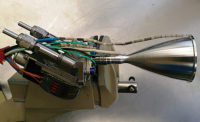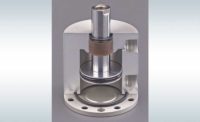When evaluating how best to attach components and assemblies in the world of compact consumer electronic devices—one of the fastest-growing categories of appliances—designers have had their work cut out for them. Restrictive design envelopes and limited footprints for attachment are among the typical issues for assembling end products ranging from wearables (smart watches, cameras, fitness bands, and headphones) to eReaders, tablets, and all innovations in between.
If disassembly for product upgrades or repairs would be anticipated down the road, threaded fasteners normally would have a leg up on competing technologies such as welds, rivets, and adhesives, which inherently make an attachment permanent. But traditional fasteners have been at odds with the goal of smaller, lighter, and thinner appliances by adding parts counts and weight. Even micro screws are an example: While still viable in many applications, their requirements for mating hardware and locking patches run counter to minimizing the amount of hardware and weight.
So a question for designers becomes: Are there effective and efficient fastener alternatives, even for applications where subsequent disassembly will not be required?
Micro fasteners as solutions
Entire families of micro fasteners provide practical solutions. These fasteners—threaded or unthreaded—have been developed to resolve the various design challenges and have certainly evolved well beyond screws.
As an example, a particular type of self-clinching micro pin can be specified to permanently attach two metal surfaces (aluminum, steel, or stainless steel) in much the same way as a screw. But, unlike a micro screw, this fastener will eliminate the need for a locking patch and mating hardware—helping to reduce assembly steps, parts counts, and weight in an assembly. And the fastener permanently joins to suit those applications where subsequent disassembly will not be a consideration.
This micro fastener offers other assembly and production advantages, too, over micro screws. The hardware exhibit higher strength against pullout compared with threaded micro screws of the same length; eliminate costly tapping, potential cross threading, need for torque control, and the issue of vibration back-out associated with micro screws; feature tapered tips to assist in accurate location before permanent installation; and can be installed automatically—saving time and money in the process. The fastener further can facilitate streamlined designs, because they are relatively smaller and weigh less than micro screw counterparts.
Many other types of micro fasteners are making their mark and, regardless of type, designers should understand that these extremely small fasteners are not simply scaled-down versions of their larger counterparts. When fastener types are downsized to lengths as short as 2mm, thread sizes as small as M0.8, and diameters under 1mm, issues relating to tight tolerances and performance values, among others, become magnified. Unique features engineered into a micro fastener become both critical and essential with specialty design coming into play.
Expanding universe of micro fasteners
The number and types of micro fasteners have expanded consistent with the many evolving applications where their specification will make particular sense.
Many examples of micro fasteners in today’s marketplace rely upon self-clinching fastener technology. The benefits of all self-clinching fasteners essentially arise from their design incorporating an annular recess (for permanently locking the fastener in place in thin ductile metal sheets) and an element to prevent fastener rotation in service.
Regardless of type, self-clinching fasteners install permanently in ductile metal sheets. They are pressed into place in a properly sized hole and, when sufficient squeezing force is applied, the fastener’s serrated clinching ring, knurl, ribs, or hex head is forced into the panel surface, displacing sheet material into a specially designed annular recess in the shank or pilot of the fastener, known as an undercut. The metal forced into the undercut secures the fastener against axial movement, while a non-round displacer secures the fastener against rotation. No secondary operations are necessary.
In the expanding “micro” universe, the following are brief profiles of some of the self-clinching fastener versions already serving in today’s (and for tomorrow’s) applications and how they are intended for use:
- Unthreaded broaching micro fasteners can attach top panels of any material (as thin as 0.2mm / .008”) securely to a base panel or chassis manufactured from common magnesium die-cast materials (such as AZ91D) or plastics (such as ABS). From a design perspective, their unique diagonal knurl effectively holds the top panel to a base panel or chassis by broaching into the base panel/chassis using a simple press-in action without requiring heat or ultrasonic operations.
- Self-clinching micro fasteners (building on micro pin designs) incorporate a unique thread-like feature to allow fastener removal when necessary. The fastener can be twisted out (unscrewed) and reinstalled one time using a thread-locking adhesive. These fasteners enable sheet-to-sheet attachment by simply pressing them into place. The fastener clinches into the base panel and its head holds the top sheet (as thin as 0.2 mm / .008”) firmly and permanently in place.
- Unthreaded self-clinching micro locating pins are designed for locating, positioning and/or alignment applications. Standard versions are manufactured from age-hardened A286 stainless steel and designed with diameters as small as 1mm / .040” and in lengths as short as 2mm / .080”.
- Threaded self-clinching micro standoffs are designed for mounting and/or spacing components in extremely limited space applications. Standard types have been developed with threads as small as M1 / #0-80 and in lengths as short as 2mm / .080”.
Applications have further fueled the development of micro fasteners beyond the self-clinching versions for metal assemblies. Among them:
- Thru-threaded brass micro inserts engineered for plastics will install (with ultrasonic equipment or with a thermal press) either in straight or tapered mounting holes. Their symmetrical design adds value in saving time during production by eliminating any need for orienting the fastener prior to installation. The inserts can be specified in thread sizes as small as M1 / #0-80 and in a variety of lengths.
- Threaded surface-mount micro spacers have been created for nut and spacer applications involving printed circuit boards. They install permanently (in the same way and at the same time as other board components) and can be specified in thread sizes as small as M1 / #0-80 and lengths as short as 1mm / 0.62”. Ultimately, these spacers eliminate any need to place hardware manually on a populated printed circuit board.
Going forward, innovations in micro fastening technology will no doubt advance, in part, as a response to customer challenges and needs. A promising trend has been a steadily growing partnership between OEM appliance designers and fastener manufacturers to develop the most practical solution for an application. Knowledge that a hardware design team is equipped to deliver, based on experience, ultimately can make all the difference as appliance applications turn even smaller, thinner, and lighter.






